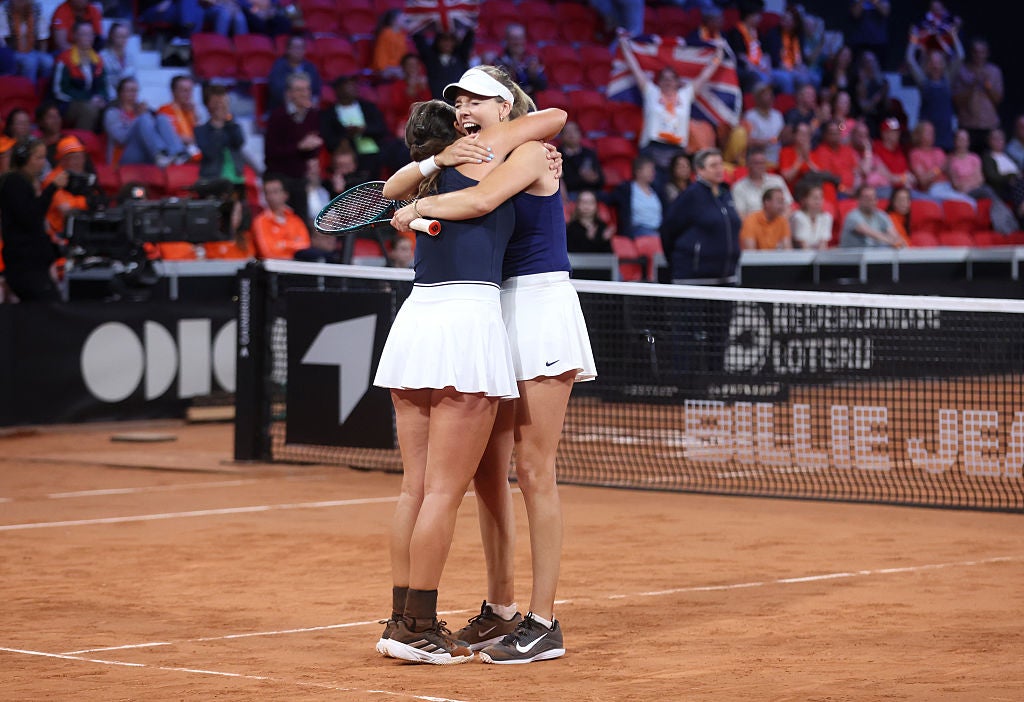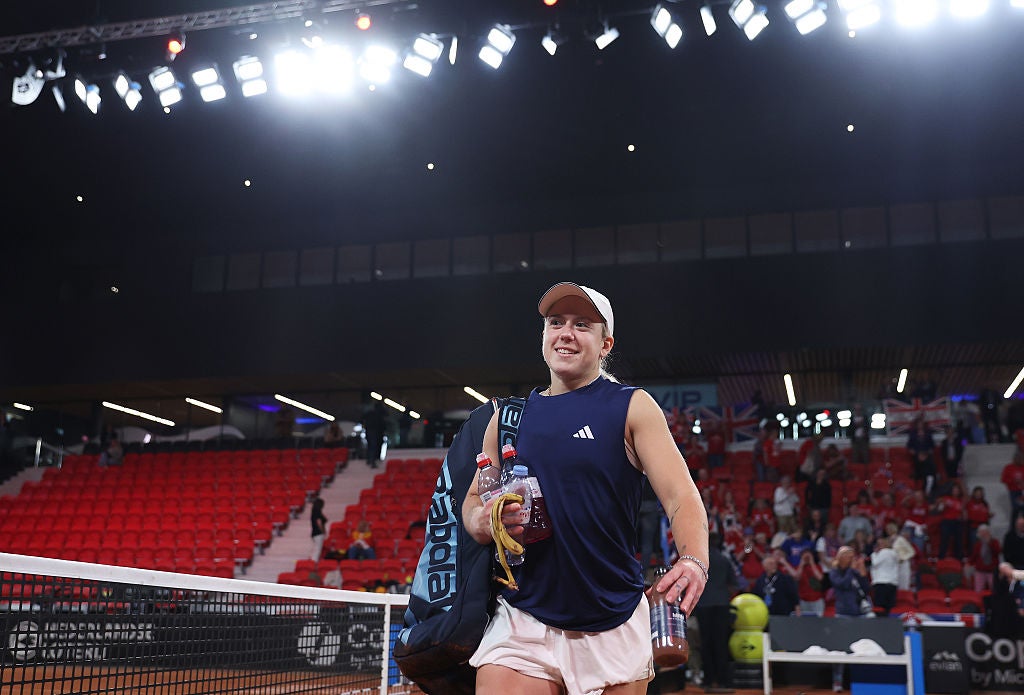
It took a brave roll of the dice by captain Anne Keothavong to turn the tables decisively in Great Britain’s favour. Last week’s Billie Jean King Cup qualifying tie hovered on a knife edge, with a deciding doubles match required to beat the Netherlands and send GB through to the Finals later this year.
GB were the favourites on paper and had recent experience of making the Finals, suffering a heartbreaking semi-final loss to Slovakia just six months ago. But a tie that should have been more straightforward proved unexpectedly tricky, as is often the case at the BJK Cup.
Debutant Sonay Kartal excelled, winning both of her two singles matches to demonstrate why she has soared up the rankings to world No. 59 this year. But GB’s No. 1 Katie Boulter had a tougher time of it in the Hague, requiring three sets to see off the wily veteran Tatjana Maria of Germany and falling in a straight-sets loss to the Netherlands’ Suzan Lamens. It was hardly surprising given she has only recently returned to action after two months out with a foot injury, and that she was rusty on indoor clay, a slower surface that neutralises her powerful style and draws out her tendency to overhit.
But knowing a defeat in the concluding doubles match would send GB home empty-handed, Keothavong opted for a radical approach. Out went Olivia Nicholls, the squad’s only doubles specialist and a recent Indian Wells finalist, and Harriet Dart, Keothavong’s preferred pairing. In came Boulter despite her singles defeat and 175th-ranked Jodie Burrage, to face off against the Netherlands’ in-form Lamens and the tie’s highest-ranked doubles player, world No. 26 Demi Schuurs. Dart and Nicholls had been swept aside by Germany on Friday night, but it was still a very risky call bringing in two power hitters who have scant experience playing doubles together.
Still, it paid off. Burrage in particular brought infectious energy, with the British pair smiling throughout, feeding off the support of the crowd and the rest of the team courtside, while the Dutch wilted. The pair were imperious behind the baseline, smashing in winners and overwhelming their opposite numbers, and as they steamrolled through the second set it felt like a berth in September’s final had their names on it. GB once again have a very good chance of finally lifting the trophy, with Japan, the USA, Kazakhstan, Ukraine, Spain, defending champions Italy and hosts China the remaining seven teams.
But the BJK Cup itself remains a tournament plagued by problems.
The women’s ‘World Cup of tennis’ has been in the wilderness for a few years as it tries to figure out a real identity. It was renamed from the Fed Cup in 2020, then spent its first four years under the new name operating with home and away ties to determine qualification spots for a somewhat unwieldy 12-team Finals in one location. After the embarrassing collapse of the planned 25-year, multi-billion-dollar Davis Cup partnership between Gerard Pique’s Kosmos and the International Tennis Federation, the ITF has overhauled both tournaments.

That has meant that the BJK Cup Finals has been slimmed down to eight teams, mirroring the men’s equivalent, with the host nation and defending champions automatically progressing. The final six are contested in a round-robin format this year; from next year the home and away ties will return.
The move to slim down the tournament, and bring it in line with the men’s equivalent, makes sense, especially given the legacy of the woman it is named after and her career-long fight for parity with the men’s tour. But something must be done to make it more attractive to players, with many of the world’s best eschewing this week’s qualifying ties altogether in favour of practicing ahead of the start of the clay season.
The three highest-ranked singles players named in the American squad, world No. 3 Jessica Pegula, former top-tenner Danielle Collins, and rising star McCartney Kessler, all pulled out at the last minute, while world Nos. 4, 5 and 11, Coco Gauff, Madison Keys, and Emma Navarro, were never involved. Poland were thumped 3-0 by Ukraine as they exited the tournament but were missing world No. 2 Iga Swiatek, who would have been expected to make a difference.

The appeal of the tournament is seeing the world’s best players competing for their country, but with plenty of nations fielding a second-string team, it seems that the majority of players don’t take it seriously. Considering the incredibly congested calendar, with ten mandatory WTA 1000 tournaments and ranking points to defend week in and week out, it feels hardly fair to blame the players for wanting a rare few days off.
On the flip side, had more of the sport’s biggest names been in action this week, more spectators might have turned up. That problem may at least be ameliorated by the return to home and away ties next year. The travelling British fans, replete with Union Jacks, bucket hats and the ever-present brass band, certainly made some noise, but the stands in the Sportcampus Zuiderpark were noticeably empty, even with the home team in action.
As for those watching, or trying to, on TV: with GB’s ties hidden away on BBC iPlayer and BBC Sport, fans could be forgiven for not knowing the tournament was happening at all – hardly a way of keeping loyal fans engaged, or broadening the event’s reach.

The point is moot anyway with the decision made to move the Finals to Shenzhen. The Chinese market is lucrative for tennis’ governing bodies, but does not make for a good atmosphere. (Perhaps the need to get bums on seats is why China, below every other squad into the knockout rounds at 22nd in the world rankings, have been awarded an automatic spot.)
That lack of atmosphere, in turn, is hardly likely to incentivise the world’s best players to make the 8,000 mile trek from the US, where the American hard-court swing will have just come to a conclusion. The BJK Cup has moved from its widely reviled November slot to mid-September, to catch players before they’re exhausted at the end of the seven-week Asian hard-court season and just want to go home. But no one who has had a deep run at the US Open is going to be keen on heading out for the Asian season early and having even less time to recover.
It feels like the Billie Jean King Cup has solved one problem by creating another, with what could be - and often is - a fantastic display of elite tennis hamstrung by familiar issues of the tennis tour. And until the tournament figures out what it is and what it means, it looks set to stagnate.
Jacob Fearnley through to next round of Barcelona Open
Carlos Alcaraz storms back to flatten Lorenzo Musetti and win first Monte Carlo title
Emma Raducanu eyeing Andy Murray’s former coach to head up her team
Child prodigy to grand slam winner: The making of Masters champion Rory McIlroy
Jodie Burrage says Great Britain will celebrate BJK Cup finals spot with a party
Great Britain fight past Netherlands to secure Billie Jean King Cup final place







